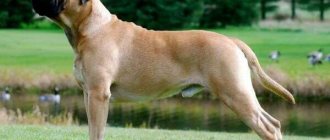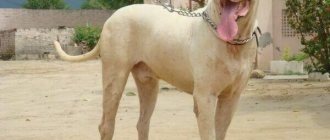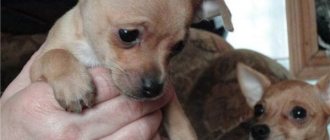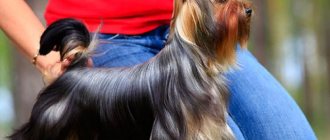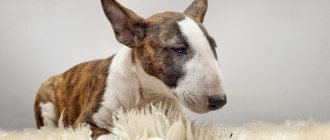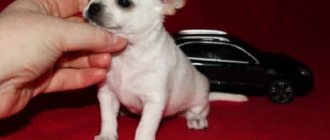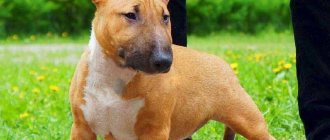Description of the breed
Labradors are dogs with a strong, proportional build. They have a slightly elongated body, a straight back line, a moderately deep chest, a large head and strong limbs.
The muzzle is not pointed, the eyes are brown or hazel, medium in size, the nose is black, but in fawn and chocolate dogs it can be brown. The ears are hanging and close to the head.
The coat is dense and hard to the touch; rich brown, fawn and black colors are acceptable.
The height of Labradors at the withers is 54-57 cm, and their weight is 27-40 kg .
Representatives of this breed, provided proper care, live an average of 12-14 years.
Growth from 1 to 12 months
The first year of a Labrador’s life deserves special attention:
| Age | Weight | Height | Description |
| 1 month | 3.4-4.8 kg | 23-32.5 | A wet and cold nose, an elastic belly, a uniform coat color, a tail similar to that of an otter. The one-month-old puppy is playful and active. |
| 2 months | 7-8 kg | 30-32.5 | At this age, the baby feels comfortable away from his mother and other puppies. Baby teeth begin to develop. |
| 3 months | 12-14 kg | 39.5-42 | It grows actively and becomes restless. From the moment of birth, growth triples. |
| 4 months | 17-19 kg | 44-46 | An awkward body, the so-called teenage period. Teeth begin to cut. The differences between females and males are visible. |
| 5 months | 21-22 kg | 48-51 | The paws lengthen, the puppy becomes stronger. Teeth change. In male dogs, the testicles droop. |
| 6 months | 24-26 kg | 50-55 | The puppy must know all commands and obey easily. Getting used to using the toilet outside the home. |
| 7 months | 26-28 kg | 52-56 | Puberty is reached. All the teeth have already changed. |
| 8 months | 28-30 kg | 54-57 | Bitches are ready for heat and can begin to mark their territory. |
| 9 months | 30-32 kg | 54-58 | The last stage of growing up occurs. The weight reaches its typical level (for females 27 kg, for males 30 kg). |
| 10 months | 32-34 kg | 54-58 | The puppy looks like an adult, its physique is completely formed. |
| 11 months | 34-36 kg | 54-60 | The dog stops growing. |
| 12 months | 30-38 kg | 54-61 | Puppies finally take on the appearance of adult dogs. Powerful and strong paws, short tail, thickened at the base. |
The growth of Labrador puppies depends on genetics, but full maturity is achieved at the age of 12 months.
Pet Personality
A good-natured disposition, love of life and an unlimited supply of positivity - these are the main qualities and characteristics of Labradors . The cheerfulness of these dogs is contagious; it is simply impossible to remain in a bad mood around them.
That is why it is believed that Labradors help create a happy, calm atmosphere of joy and harmony in the house.
Representatives of this breed cannot be called passive, their energy is overflowing, they love active games and communication and easily establish friendly relationships with both people and other pets.
Being smart and quick-witted animals, Labradors are easy to educate and train; mastering new commands is not a problem for them.
Difficulties during exercise can arise only because of the curiosity and increased playfulness of these dogs - they can be distracted by external stimuli, so the owner requires patience and the ability to switch the pet’s attention to himself.
How much does a Labrador Retriever cost?
The most affordable offers are “hand-off” puppies, without documents and pedigree, but we remind you once again: this way you risk becoming the owner of a dog with poor health or completely devoid of the “trademark” qualities of a Labrador due to the admixture of unknown genes.
A child with papers who cannot count on participation in exhibitions due to more or less significant defects in appearance will cost 50 thousand rubles. Of course, this moment does not matter if you just dream of an affectionate and devoted friend for the whole family.
Dogs of the so-called show class, whose parents are recognized champions, and whose characteristics exactly correspond to the breed standard, are much more expensive - in the range of 60-80 thousand rubles. In this case, you will be able to present your pet to a strict court of experts and hope for prizes.
Advantages and disadvantages
Like other breeds, Labradors have advantages and disadvantages that are important to know about before purchasing a puppy to avoid any unpleasant surprises.
The advantages include:
- attractive appearance;
- friendliness;
- ability to learn;
- no need for labor-intensive care;
- people-oriented;
- obedience;
- ability to get along with animals and children;
- energy;
- lack of aggression.
Cons of the breed:
- lack of watchdog and security qualities;
- tendency to chew on everything;
- snore;
- constant shedding;
- need for attention;
- binge eating;
- tendency to obesity.
Despite the fact that the breed has many shortcomings, it is worth understanding that most of them are the result of improper upbringing and care of the pet or inflated expectations of the owners and insufficient awareness of the characteristics of the breed.
Popular nicknames
The question of what to name a puppy should be taken seriously. The name should be simple and suitable for the pet.
The following nicknames are suitable for male Labrador puppies:
- Tyson;
- Jack;
- Bonya;
- Caesar;
- Rex;
- Hachiko;
- Graph;
- Baby;
- Ricci.
The girl can be called by the following names:
- Jaycee;
- Alma;
- Lucky;
- Bagheera;
- Gerda;
- Jesse;
- Nika;
- Eve.
Where is it better to keep: in an apartment or on the street?
Labradors can be kept outside , but only if you have a spacious, equipped, warm enclosure .
It should be located in a place from which the dog will have a view of the entire yard. You should also spend as much time as possible with your pet so that he does not feel lonely and abandoned.
NOTE!
You can keep a dog in an apartment if it is possible to provide it with a sufficient level of mental and physical activity.
Labradors need long daily walks and active play.
You can't keep a Labrador on a chain.
Coat
In a Labrador it is completely smooth, as if covered with wax. Elastic and thick hairs are no more than five centimeters in length. They are quite stiff and straight.
Handsome retrievers have soft, silky, long fur. Luxurious waves decorate the paws, neck, hips and tail of the animal. This decorative wool reveals their noble origin.
The breed was developed by the Scottish lord Sir Tweedmouth, who spent half his life trying to obtain a golden color that can have all shades of red. In our opinion, it is quite obvious how different a retriever and a Labrador are in appearance. What is the difference? The photo below answers this question.
Goldens have a more decorative appearance. Magnificent coat, waterproof undercoat, beautiful feathering, shining wheat-golden color and aristocratic habits in every movement. The frame is more lightweight than powerful.
The Labrador is a compact dog with short, close-fitting hair. The guard hair of a healthy animal is shiny and slightly greasy. This is due to the lack of undercoat. Labradors are noticeably wider and more massive than retrievers; adult animals have dewlaps (folds of skin) on their necks.
How active are they? What kind of people is it suitable for?
Labradors, thanks to their sociable nature and ability to adapt to new conditions, easily adapt to the habits and lifestyle of their owners . Perhaps the only thing they cannot come to terms with is a passive lifestyle.
Therefore, elderly people and those who cannot devote enough time to walk with their pet should not get a dog of this breed.
These are dogs for those who lead an active life, are interested in hunting, sports, tourism and simply do not like to sit still.
The owner of a Labrador must be a strong-willed person with a strong character, a leader who will not let the dog get bored and can direct its energy in the right direction.
Place for a puppy
In the house where a small Labrador puppy appears, you need to set aside a special place for the new family member. Soft bedding and favorite toys are mandatory attributes. The pet should know its nook where it can play and relax.
When the puppy is too annoying, you need to take him to the designated mat and sternly say: “Place!” Gradually, the pet will understand that this is its personal space and will go to its “place” at the owner’s command.
How to feel about loneliness
This is a perfect example of companion dogs that are completely people-oriented and dependent on their attention . Labradors strive to spend as much time as possible with their owner and participate in his life.
IMPORTANT!
They need communication just like food and walks, and they can adapt to the mood and habits of the owner, knowing when it is better not to demand undivided attention, but simply to be nearby.
They have a hard time with loneliness; melancholy and lack of attention can cause destructive behavior.
Nutrition
The basis of the diet of an adult representative of the breed is food rich in amino acids, complex carbohydrates and proteins. Such substances are present in cereals, meat and dairy products. a Labrador puppy should receive microelements contained in fruits, as well as vitamins found in vegetables. He will gain weight gradually. Let's consider a daily menu option for a baby retriever:
- Boiled cow's milk + 100 grams of raw chicken.
- Buckwheat with milk or cottage cheese.
- Boiled or steamed vegetables, such as peppers, broccoli and carrots.
- 100 grams of raw meat.
- Fruits, for example banana.
Cereals can be replaced with soup or broth. Gradually, the amount of food for the dog needs to be increased. This is required for the gradual growth of bones and muscles. An adult representative of the breed can be switched to premium dry food.
Their use of this product has a number of advantages. Firstly, the animal that consumes it will definitely be well-fed and healthy. Secondly, you won't have to cook for it often (trust me, you'll save a lot of time).
In addition, do not forget to treat your dog with berries. She really loves melon, watermelon or raspberries. Never give her spicy fish or chicken bones! They can get stuck in the animal's throat and even lead to its death. Also limit his consumption of processed meats, fatty and fried foods, and smoked foods.
Who to choose - a boy or a girl?
When choosing the gender of your future pet, you should start from the purpose of acquiring it and some psychological and behavioral differences between males and females, due to the performance of different functions in the pack.
The task of male dogs is to explore new places and protect the territory. They are inquisitive and persistent, have leadership qualities, but have no problem obeying someone who is stronger.
The main function of bitches is reproduction. They are more cunning than males and achieve their goals not by acting blindly, but by going through all the options.
Girls are more obedient and calm; it is a little more difficult to achieve obedience from male dogs, but if leadership qualities are demonstrated in a timely manner, problems will not arise.
The maintenance of a dog also affects its physiology. Thus, male dogs, due to the need to mark territory, require longer walks, they are characterized by increased sexuality, which is why they can run after a female in heat.
In girls, behavior changes only during the period of estrus , i.e. no more than 2 times a year, the rest of the time she is sexually neutral .
If there are plans to breed a breed, then the choice should be made in favor of a female.
Basic rules for caring for a puppy
Caring for a Labrador puppy requires the owner to have certain knowledge and skills. Bathing an animal, combing its fur, brushing its teeth and ears, and trimming its claws - you need to learn all this and try to carry out the necessary manipulations patiently and conscientiously.
Your pet should be accustomed to hygiene procedures while it is small, otherwise problems may arise later.
Cleaning teeth and ears
Cleaning a dog's teeth and ears should become a habit for both owner and pet. The health and well-being of your Labrador depends on the regularity of these procedures. Before starting the procedure, you must carefully examine the animal's ears and teeth for infections, wounds or inflammation.
For ear hygiene, use a cotton pad soaked in a special lotion for cleaning the ears. You should pull the animal's ear back and gently wipe its surface from the inside. Lotions dissolve earwax very well.
Do not use alcohol- or oil-containing liquids. It is not recommended to use cotton swabs or tweezers wrapped in gauze to clean your ears. The skin inside the ears is thin and delicate, and it is very easy to damage it.
Your pet's teeth also need regular care. The procedure is carried out with a special dental product purchased at a pet store. You can brush your dog's teeth with your finger wrapped in a bandage or with a dog tooth brush.
These hygiene measures should be carried out at least once a week.
When teeth change
At 3 months old, a healthy Labrador puppy looks like a completely happy, restless and cheerful animal. The only thing that can interfere with him during this period of life is changing teeth.
A Labrador's teeth change between the ages of 3–3.5 and 9 months. The milky ones are replaced by permanent ones.
The process of changing teeth takes place in the following order:
- at about 3 months the primary incisors change;
- from 4 to 5 months, premolar teeth grow;
- At 6 months, a Labrador retriever's fangs fall out and molars—molars—appear;
- Usually at 9 months the animal should have 42 teeth - a full set of adult pets.
During this period, it is necessary to inspect the dog’s mouth more often (2-3 times a week). If a baby tooth is very loose, you can pull it out by carefully grasping it with two fingers.
When the process of replacing teeth is very late, it is worth contacting a veterinarian. Timely replacement of teeth in a Labrador affects the correct formation of the bite and jaws.
It is important to know! During the change of baby teeth, the puppy needs to gnaw or chew something. To prevent your pet from damaging your shoes or furniture, you need to give him a toy or ball. You can also massage your gums.
In large breeds of dogs, the process of replacing teeth goes smoothly. However, during this difficult period you should refrain from vaccinations and feed your dog properly.
Nail trimming
Nail trimming is carried out with special forceps - a nail clipper. This is done very carefully so as not to damage the paw pads and not to cut the claw very deeply. It is better if someone holds the puppy while doing this.
Carefully taking the dog's paw in your hand and spreading the fingers, you need to cut off the ends of the claws parallel to the pads. Then, when the pet gets used to the procedure, it will be possible to do without outside help.
Grooming
Caring for the coat of a small Labrador is not difficult at all, as it is smooth and short. It is enough to brush your pet 2-3 times a week with a dog brush. To prevent your pet from developing dandruff, you can wash it with a special shampoo. However, you should not bathe your dog very often - once every one and a half to two months is quite enough.
During the bathing process, you need to make sure that water and shampoo do not get into the eyes, ears or mouth of the animal. Labradors are usually not averse to swimming and playing in a pond, but not all dogs like swimming.
How to care for Labrador puppies at the age of 1 month? A similar problem can arise if for some reason the mother dog is not around. First of all, you need to monitor the body temperature of small puppies. Normally, it should be no lower than 35 degrees. Puppies should eat every hour and a half.
It is advisable that the mother feeds them herself. It is necessary to monitor the baby's weight gain. If there is a shortage, you need to start feeding them.
Good or evil?
Labradors are absolutely not characterized by aggressive behavior - they are good-natured dogs that are friendly to everyone. Therefore, they are not suitable for the role of guards or watchmen.
The maximum that can be expected from representatives of this breed who see strangers on their territory is a loud bark, notifying the owners of someone’s visit..
Colors
The pale-golden color of the coat is one of the reasons why (according to some novice dog breeders) the Labrador and Golden Retriever are so similar. What is the difference in the colors of these animals? In fact, breed standards clearly describe the acceptable colors and shades of animal coats.
The retriever's coat can be golden in color with various shades of red. Moreover, according to the standard, copper-red is as valuable as platinum-white. The basic requirements relate only to the zonal distribution of colors and shades.
Labrador retrievers are characterized by fawn-beige, black, brown and golden colors. At first, only black individuals were recognized and allowed for breeding. Breeders had to seriously fight for brown and golden colors.
How does he treat children?
Good-natured, active, affectionate Labradors get along well with everyone, including children.
Despite the fact that they are not prone to aggression and without any problems become excellent nannies and best friends for children, families where the child is not yet at least 10 years old should not get a dog of this breed.
This is due to the irrepressible energy and high emotionality of representatives of this breed - in an excited state and trying to express their love, they can unintentionally push the baby or bite lightly, which will lead to fright.
Brief history of origin
Today there is no reliable information about the history of the origin of the Labrador Retriever breed. There is a version that a “little Newfoundland” dog was found on the island of Newfoundland. These animals were very hardworking and resilient. They helped fishermen and hunters.
In the 19th century, these dogs were brought to England, where they were crossed with the Curly-Coated Retriever. The result of this experiment was a Labrador. In the twentieth century they appeared in America.
The first breed standard was established in England in 1988, in the USA in 1994.
How picky is she about feeding?
Labradors require a balanced diet, but this is due to their susceptibility to allergies, obesity and other health problems, not their taste preferences.
These dogs are not picky eaters and are practically omnivorous..
Their tendency to eat the contents of a garbage bag or something on the street while walking is often noted, so you should be careful - eating low-quality products can be dangerous.
Reviews
- Marina. If you treat your Labrador correctly, there will be no end to the joyful emotions! Of course, if you don't keep the animal busy, it can cause mischief. So it was with my beauty. But she got along well with my little son and tolerates all his squeezing. If it weren't for the fur during shedding, it would be completely fine. But these are small things compared to all the good things that our Labrador brought me.
- Stepan. For me, the Labrador has become my best friend. He doesn’t get very tired when we walk, but he doesn’t rush to go outside when we haven’t spent enough time outdoors. He understands everything I tell him; the main thing for him is to be with his owner. It’s worth getting a Labrador – this is a very worthy and kind breed.
- Alyona. The dog, of course, is very kind and smart, but he chewed everything he could in the house, even children’s toys. We played football, were touched by this “little” puppy with the whole family, but still returned it. My daughter was overwhelmed and it was difficult to feed the Labrador. Maybe after some time I will be able to accept such a friend, but not now.
- Ivan. They didn't take a puppy, but a teenager. It was very difficult. There was a feeling that this dog had suicidal tendencies. Then he takes everything in a row, often eats it all. Crashes into objects and people. I finally achieved my goal. He died during an operation - they wanted to get another eaten trophy out of his stomach.
- Arseny. We bought it when I was pregnant. They thought that Labradors were obedient from birth. It turned out that everything is not so simple. Anything could happen, but what unsettled me was the very frequent trips to the toilet right in the apartment. But, thank God, we managed to cope with this. The child was born, grew up, and now he and the dog are best friends. And this is the most important thing. We were not mistaken: the Labrador is the best friend of the family.
Recommended reading:
Australian Shepherd: description of the breed, origin, care and education
Labrador - puppy Labrador - dog Labrador breed Dog breed Labrador Labrador breed
Another way to distinguish dogs
Among dog handlers, there are comic instructions that will help to distinguish between a Labrador and a Golden Retriever. It is necessary to plant representatives of these breeds on the bank of the river and throw a stick into the water. One dog will end up in the river while the stick is flying, and the second, without leaving its place, will assess the direction of the current and its speed, look at the sky, smell the air, remember the weather forecast that the owner read in the morning, and only after that will go into the water. As you may have guessed, the second dog will be a golden retriever.
As you can see, Labrador and Retriever have completely different characters. You already know what the difference between them is. It remains to understand in which families representatives of these breeds will be more comfortable. Labrador is more suitable for families with teenage children. After all, during a game or on a walk, a fairly strong dog may not calculate its strength and snatch the leash from the hands of a small child.
The retriever is also a family dog, but thanks to its restraint, it will become a nanny even for very young children. His temperament also copes with older people.
